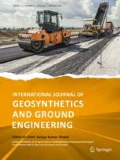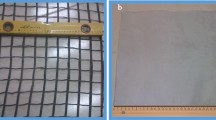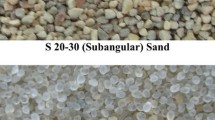Abstract
The shear resistance at soil–geomembrane interfaces is critically important for the proper design of geomembrane-lined side slopes of landfills, reservoirs, and canals. The dependable design and construction of such applications is enhanced by the experimental documentation of the interaction behavior between different soils and various geomembrane types. Toward this end, direct shear tests were conducted on 29 soil–geomembrane interfaces using a conventional (100 mm) shear box. Two dry and dense uniform sands, one with rounded and one with sub-angular grains of the same size, and one compacted cohesive soil of low plasticity were tested in contact with seven geomembranes of different types with smooth or rough surfaces. The direct shear tests yielded linear failure envelopes with no adhesion for the sand–geomembrane interfaces and polynomial failure envelopes for the cohesive soil–geomembrane interfaces, possibly indicating a transition from drained to undrained conditions at the interface with increasing normal stress. Sub-angular sand grains, soft geomembranes, and rough geomembrane surfaces were found to mobilize interface shear resistance more effectively. The shear resistance parameters are functions of the shearing displacement at the cohesive soil–geomembrane interfaces and their values at failure reveal a transition from “friction-like” behavior to “adhesion-like” behavior as normal stress increases. The ratio between the friction coefficient values for the sand–geomembrane interfaces tested ranges from approximately 1 to 2. For the geomembrane types tested, differences in failure shear stress at the cohesive soil–geomembrane interfaces are generally limited to ± 20%.












Similar content being viewed by others
References
Koerner RM (2005) Designing with geosynthetics, 5th edn. Pearson–Prentice Hall, Upper Saddle River
Izgin M, Wasti Y (1998) Geomembrane–sand interface frictional properties as determined by inclined board and shear box tests. Geotext Geomembr 16:207–219
Lopes PC, Lopes ML, Lopes MP (2001) Shear behaviour of geosynthetics in the inclined plane test—influence of soil particle size and geosynthetic structure. Geosynth Int 8:327–342
Ling HI, Burke C, Mohri Y, Matsushima K (2002) Shear strength parameters of soil-geosynthetic interfaces under low confining pressure using a tilting table. Geosynth Int 9:373–380
Palmeira EM, Lima NR Jr, Mello LGR (2002) Interaction between soils and geosynthetic layers in large-scale ramp tests. Geosynth Int 9:149–187
Gourc JP, Reyes Ramirez R (2004) Dynamics-based interpretation of the interface friction test at the inclined plane. Geosynth Int 11:439–454
Negussey D, Wijewickreme WKD, Vaid YP (1989) Geomembrane interface friction. Can Geotech J 26:165–169
Stark TD, Poeppel AR (1994) Landfill liner interface strengths from torsional-ring-shear tests. J Geotech Eng 120:597–615
Vaid YP, Rinne N (1995) Geomembrane coefficients of interface friction. Geosynth Int 2:309–325
Fannin RJ, Raju DM (1993) On the pullout resistance of geosynthetics. Can Geotech J 30:409–417
Eigenbrod KD, Locker JG (1987) Determination of friction values for the design of side slopes lined or protected with geosynthetics. Can Geotech J 24:509–519
Williams ND, Houlihan MF (1987) Evaluation of interface friction properties between geosynthetics and soils. In: Proceedings of geosynthetics’87 conference, New Orleans, vol 2, Industrial Fabrics Association International, Roseville, MN, pp 616–627
Weiss W, Batereau C (1987) A note on planar shear between geosynthetics and construction materials. Geotext Geomembr 5:63–67
O’Rourke TD, Druschel SJ, Netravali AN (1990) Shear strength characteristics of sand-polymer interfaces. J Geotech Eng 116:451–469
Cadwallader MW (1991) Addressing the special concerns of landfill closures: VLDPE and textured geomembranes. Geotext Geomembr 10:411–425
Ojeshina AO (1991) A new high friction HDPE geomembrane. Geotext Geomembr 10:433–441
Koutsourais MM, Sprague CJ, Pucetas RC (1991) Interfacial friction study of cap and liner components for landfill design. Geotext Geomembr 10:531–548
Imaizumi S, Nishigata T, Iimura K (1994) Effect of variation in sample sizes on soil-polymer interface strength. In: Proceedings of the 5th international conference on geotextiles, geomembranes and related products, vol 1, SEAC-IGS, Singapore, pp 423–426
Young RA (1994) Direct shear tests used in soil-geomembrane interface friction studies. Report No. R-94-09, U.S. Department of the Interior—Bureau of Reclamation
Orman ME (1994) Interface shear-strength properties of roughened HDPE. J Geotech Eng 120:758–761
Nataraj MS, Maganti RS, Mc Manis KL (1995) Interface frictional characteristics of geosynthetics. In: Proceedings of geosynthetics’95, Nashville, vol 3, Industrial Fabrics Association International, Roseville, MN, pp 1057–1069
Bouazza A (1998) Evaluation of soil–geosynthetics interaction for some landfills in Algiers. In: Proceedings of the 6th international conference on geosynthetics, Atlanta, vol 1, pp 459–462
Dove JE, Frost JD (1999) Peak friction behavior of smooth geomembrane-particle interfaces. J Geotech Geoenviron Eng 125:544–555
Zettler TE, Frost JD, DeJong JT (2000) Shear-induced changes in smooth HDPE geomembrane surface topography. Geosynth Int 7:243–267
Hsieh C, Hsieh M-W (2003) Load plate rigidity and scale effects on the frictional behavior of sand/geomembrane interfaces. Geotext Geomembr 21:25–47
DeJong JT, Westgate ZJ (2005) Role of overconsolidation on sand–geomembrane interface response and material damage evolution. Geotext Geomembr 23:486–512. https://doi.org/10.1016/j.geotexmem.2005.04.001
Yamsani SK, Sreedeep S, Rakesh RR (2016) Frictional and interface frictional characteristics of multi-layer cover system materials and its impact on overall stability. Int J Geosynth Ground Eng 2:23. https://doi.org/10.1007/s40891-016-0063-5
Vangla P, Gali ML (2016) Shear behavior of sand-smooth geomembrane interfaces through micro-topographical analysis. Geotext Geomembr 44:592–603. https://doi.org/10.1016/j.geotexmem.2016.04.001
Frost JD, Karademir T (2016) Shear-induced changes in smooth geomembrane surface topography at different ambient temperatures. Geosynth Int 23:113–128. https://doi.org/10.1680/jgein.15.00036
Punetha P, Mohanty P, Samanta M (2017) Microstructural investigation on mechanical behavior of soil–geosynthetic interface in direct shear test. Geotext Geomembr 45:197–210. https://doi.org/10.1016/j.geotexmem.2017.02.001
Fowmes GJ, Dixon N, Fu L, Zaharescu CA (2017) Rapid prototyping of geosynthetic interfaces: investigation of peak strength using direct shear tests. Geotext Geomembr 45:674–687. https://doi.org/10.1016/j.geotexmem.2017.08.009
Criley KR, Saint John D (1997) Variability analysis of soil vs. geosynthetic interface friction characteristics by multiple direct shear testing. In: Proceedings of geosynthetics’97, Long Beach, vol 2, pp 885–897
Goodhue MJ, Edil TB, Benson CH (2001) Interaction of foundry sands with geosynthetics. J Geotechn Geoenviron Eng 127:353–362
Fleming IR, Sharma JS, Jogi MB (2006) Shear strength of geomembrane–soil interface under unsaturated conditions. Geotext Geomembr 24:274–284. https://doi.org/10.1016/j.geotexmem.2006.03.009
Koerner RM, Martin JP, Koerner GR (1986) Shear strength parameters between geomembranes and cohesive soils. Geotext Geomembr 4:21–30
Mitchell JK, Seed RB, Seed HB (1990) Kettleman Hills waste landfill slope failure. I: liner-system properties. J Geotech Eng 116:647–668
Seed RB, Boulanger RW (1991) Smooth HDPE-clay liner interface shear strengths: compaction effects. J Geotech Eng 117:686–693
Swan RH Jr, Bonaparte R, Bachus RC, Rivette CA, Spikula DR (1991) Effect of soil compaction conditions on geomembrane-soil interface strength. Geotext Geomembr 10:523–529
Fishman KL, Pal S (1994) Further study of geomembrane/cohesive soil interface shear behavior. Geotext Geomembr 13:571–590
Masada T, Mitchell GF, Sargand SM, Shashikumar B (1994) Modified direct shear study of clay liner–geomembrane interfaces exposed to landfill leachate. Geotext Geomembr 13:165–179
Esterhuizen JJB, Filz GM, Duncan JM (2001) Constitutive behavior of geosynthetic interfaces. J Geotechn Geoenviron Eng 127:834–840
Ling HI, Pamuk A, Dechasakulsom M, Mohri Y, Burke C (2001) Interactions between PVC geomembranes and compacted clays. J Geotechn Geoenviron Eng 127:950–954
Bacas BM, Cañizal J, Konietzky H (2015) Frictional behaviour of three critical geosynthetic interfaces. Geosynth Int 22:355–365. https://doi.org/10.1680/gein.15.00017
Stark TD, Niazi FS, Keuscher TC (2015) Strength envelopes from single and multi geosynthetic interface tests. Geotech Geol Eng 33:1351–1367. https://doi.org/10.1007/s10706-015-9906-4
Chai J-C, Saito A (2016) Interface shear strengths between geosynthetics and clayey soils. Int J Geosynth Ground Eng 2:19. https://doi.org/10.1007/s40891-016-0060-8
Feligha M, Hammoud F, Belachia M, Nouaouria MS (2016) Experimental investigation of frictional behavior between cohesive soils and solid materials using direct shear apparatus. Geotech Geol Eng 34:567–578. https://doi.org/10.1007/s10706-015-9966-5
Dixon N, Jones DRV, Fowmes GJ (2006) Interface shear strength variability and its use in reliability-based landfill stability analysis. Geosynth Int 13:1–14
Sia AHI, Dixon N (2007) Distribution and variability of interface shear strength and derived parameters. Geotext Geomembr 25:139–154. https://doi.org/10.1016/j.geotexmem.2006.12.003
ASTM E11 (2009) Standard specification for wire cloth and sieves for testing purposes. ASTM International, West Conshohocken
ASTM D422 (2007) Standard test method for particle-size analysis of soils. ASTM International, West Conshohocken
ASTM D5321 (2006) Standard test method for determining the coefficient of soil and geosynthetic or geosynthetic and geosynthetic friction by the direct shear method. ASTM International, West Conshohocken
EN ISO 12957–1 (2005) Geosynthetics—determination of friction characteristics: part 1—direct shear test. European Committee for Standardization, Brussels
Takasumi DL, Green KR, Holtz RD (1991) Soil–geosynthetics interface strength characteristics: a review of state-of-the-art testing procedures. In: Proceedings of geosynthetics’91, Atlanta, pp 87–100
Markou IN (2018) A study on geotextile–sand interface behavior based on direct shear and triaxial compression tests. Int J Geosynth Ground Eng 4:8. https://doi.org/10.1007/s40891-017-0121-7
Giroud JP, Darrasse J, Bachus RC (1993) Hyperbolic expression for soil-geosynthetic or geosynthetic-geosynthetic interface shear strength. Geotext Geomembr 12:275–286
Fourie AB, Fabian KJ (1987) Laboratory determination of clay–geotextile interaction. Geotext Geomembr 6:275–294
Athanasopoulos GA (1996) Results of direct shear tests on geotextile reinforced cohesive soil. Geotext Geomembr 14:619–644
Schmertmann JH, Osterberg JO (1960) An experimental study of the development of cohesion and friction with axial strain in saturated cohesive soils. In: Proceedings of the research conference on shear strength of cohesive soils, Boulder. American Society of Civil Engineers, Reston pp 643–694
Markou IN, Atmatzidis DK (2003) Mechanical behavior of a pulverized fly ash grouted sand. Geotech Test J 26:450–460
Markou IN, Droudakis AI (2013) Shear strength of microfine cement grouted sands. Ground Improv 166:177–186. https://doi.org/10.1680/grim.12.00016
Makiuchi K, Miyamori T (1988) Mobilization of soil–geofabric interface friction. In: Proceedings of the international geotechnical symposium on theory and practice of earth reinforcement, Fukuoka, pp 129–134
Gomes RC, Palmeira EM, Vidal D (1994) Soil reinforcement interaction by in-soil tensile tests and direct shear tests. In: Proceedings of the 5th international conference on geotextiles, geomembranes and related products, vol 1. SEAC-IGS, Singapore, pp 395–400
Acknowledgements
The interface direct shear tests reported herein were conducted in the Soil Mechanics and Foundation Engineering Laboratory of Democritus University of Thrace, under the supervision of the first author, by the students E. Chalvatzopoulou, Th. Gkeki, M. Papadopoulou, and E. Sfiri, whose careful work is gratefully acknowledged.
Author information
Authors and Affiliations
Corresponding author
Rights and permissions
About this article
Cite this article
Markou, I.N., Evangelou, E.D. Shear Resistance Characteristics of Soil–Geomembrane Interfaces. Int. J. of Geosynth. and Ground Eng. 4, 29 (2018). https://doi.org/10.1007/s40891-018-0146-6
Received:
Accepted:
Published:
DOI: https://doi.org/10.1007/s40891-018-0146-6




